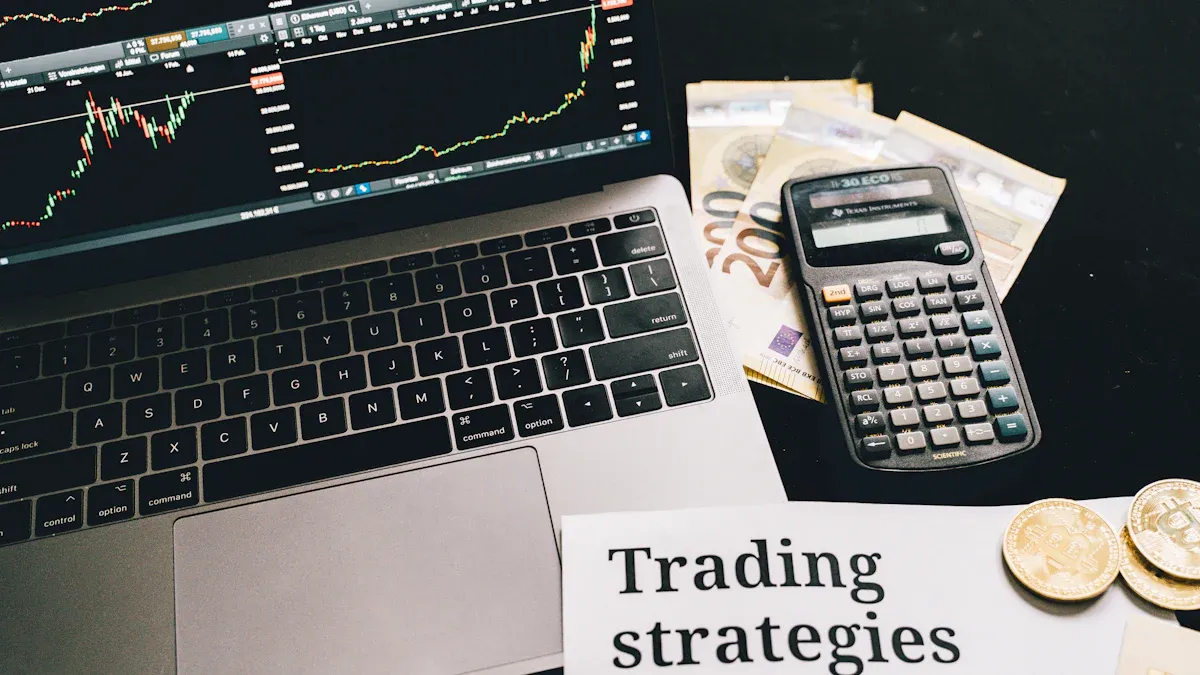Image Source: unsplash
Handling investment risks is key to reaching money goals, especially when considering ‘Investment Risk Management: How to Effectively Control Portfolio Volatility.’ Ignoring this can lead to money loss and worry. Without a plan, changes in investments can ruin good strategies. I aim to share steps to face these problems easily and surely.
Key Takeaways
- Learn about types of investment risks like market and specific risks. This helps you make smart choices for your money goals.
- Spread your investments in different industries and places. This lowers risk and can increase your chances of earning more.
- Check and change your investments often. Match them to your comfort with risk and market changes to grow steadily.
Understanding Investment Risk and Portfolio Volatility
What Is Investment Risk and Why Does It Matter?
Investment risk means you might lose money or earn less. Every investment has some risk, and it’s important to know this. Risks can be different types:
- Systematic Risk affects all investments and cannot be avoided.
- Unsystematic Risk is tied to one company or industry but can be reduced by spreading investments.
- Market Risk comes from changes in market prices.
- Credit Risk happens when borrowers don’t pay back what they owe.
- Liquidity Risk makes it hard to sell or buy investments easily.
Knowing these risks helps me make better choices. It ensures my investments match my goals and comfort with risk.
Defining Portfolio Volatility and Its Impact on Returns
Portfolio volatility shows how much investment values go up and down. I think of it as a measure of uncertainty. High volatility means more risk but can also mean bigger rewards. For example, stocks change more than bonds but can grow more over time. Managing volatility is important because big changes can hurt returns and cause bad decisions. By keeping volatility in check, I aim for steady growth over time.
The Interplay Between Risk, Volatility, and Investment Outcomes
Risk and volatility are connected. More risk often means more volatility, which affects results. I’ve learned balancing these is key to managing investments well. For example, spreading investments across different types reduces unsystematic risk and smooths out volatility. This method follows the idea of investment risk management: how to control portfolio volatility while reaching money goals.
Assessing and Aligning Risk Tolerance
Key Factors That Shape Your Risk Tolerance
Knowing what affects risk tolerance is important for smart investing. Many things influence how much risk I can handle:
- Overestimating Capability or Experience: Thinking I’m better than I am can lead to risky moves.
- Familiarity With Tasks: Doing similar investments often might make me too comfortable, raising risks.
- Severity of Outcome: Knowing how much I could lose helps me make safer choices.
- Social Pressures: Friends or work culture might push me to take more or less risk.
- Personal Experience: Past big wins or losses affect how I feel about risks.
By understanding these, I can know my risk limits and decide wisely.
Tools and Methods to Determine Your Risk Profile
Finding my risk profile means using tools to check my goals, timeline, and feelings about market changes. Helpful methods include:
- Risk Tolerance Questionnaires: These quizzes show how I feel about losing or gaining money.
- Monte Carlo Simulations: This tool guesses how my investments might do in different situations.
- Historical Analysis: Looking at past results helps me see how I handle ups and downs.
These tools teach me about my risk comfort, helping me match my portfolio to my goals.
Aligning Portfolio Allocation With Risk Tolerance
Once I know my risk tolerance, I can set up my portfolio to match it. Good strategies include:
- Asset Allocation: I split my money between stocks, bonds, and other types based on my risk level and timeline.
- Diversification: Investing in different areas lowers the chance of losing too much in one place.
- Adjusting Over Time: Checking my portfolio often keeps it in line with my changing goals and the market.
By doing this, I can balance risk and reward, helping my portfolio grow steadily for the future.
Easy Ways to Manage Investment Risks
Spreading Investments Across Sectors and Locations
Spreading out investments helps lower risks. I do this by putting money in different industries and countries. This way, if one area struggles, my whole portfolio isn’t hurt. Here’s why this works:
- Reduces big losses in one market.
- Focuses on lowering risks instead of just chasing profits.
- Boosts returns by mixing investments that don’t move the same way.
| Benefit | What It Means |
|---|---|
| Lower Risk | Investing in many places reduces risks tied to one region. |
| Balances Market Changes | Helps steady the portfolio when some markets are unstable. |
| Easier Global Investing | Tools like ETFs and mutual funds make it simple to invest worldwide. |
By spreading my investments, I keep my portfolio strong, even when markets are shaky.
Adjusting Portfolios Without Adding Risk
Adjusting my portfolio keeps it on track with my goals. Here’s how I do it:
- Stick to my planned mix of stocks, bonds, and other assets.
- Bring investments back to the original plan to manage risks.
- Save on taxes and fees by timing trades smartly or using special accounts.
Regular adjustments help me stay focused and avoid taking on too much risk.
Changing Investments for Market Shifts
Markets change often, so I adjust my investments to match. This lets me:
- Change my portfolio for short-term market trends.
- Take advantage of market mistakes to earn more.
- Avoid risky investments during uncertain times.
- Protect my money by preparing for economic changes.
This flexible method helps me handle market ups and downs while staying on track with my goals.
Using Stop-Loss Orders to Protect Money
Stop-loss orders are a simple way to limit losses. When a set price is hit, the order sells the investment at the best price available. But I’m careful about problems like sudden price drops or selling too soon.
| Good Things About Stop-Loss Orders | Problems With Stop-Loss Orders |
|---|---|
| Limits how much I can lose. | Small price changes might cause early selling. |
| Doesn’t need constant watching. | Selling price might not match the stop price. |
| Cheap to set up. | No clear rules for choosing the stop price. |
By setting stop-loss orders wisely, I protect my investments without always watching them.
Using Options to Handle Market Changes
Options are another way I manage risks. They give me choices to protect my portfolio during tough times:
| Strategy | What It Does |
|---|---|
| Covered Calls | Earns money by selling call options while holding the asset. |
| Married Puts | Buys a put option for owned shares to protect against losses. |
| Protective Puts | Acts as insurance by buying puts, though it costs a fee. |
Options help me guard against losses while still aiming for growth.
Controlling Portfolio Volatility Effectively
Setting a Maximum Loss Plan
I first decide how much I can afford to lose. This is called a maximum loss plan. It helps me avoid big losses, especially in bad markets. By setting a clear loss limit, I invest more carefully. This plan keeps my risks in line with my money goals. Knowing my possible losses helps me control changes in my portfolio. It also keeps me calm during tough times.
Creating a Portfolio With Different Types of Investments
I use different investments to lower risk. I pick ones that don’t move the same way. For example:
- Bonds, like AGG or IEF, stay steady.
- Commodities, such as GLD or DBC, act differently than stocks.
This mix spreads out risk and gives steady returns. While it doesn’t remove all risks, it helps me manage them better. It also keeps my portfolio balanced when markets change.
Adding a Safety Margin to Investment Choices
I always leave room for safety in my decisions. This safety margin protects me from losing too much. It helps with surprises, like market drops or company problems. A good safety margin also guards against mistakes I might make. By using this method, I get steadier returns, even when markets are shaky.
Managing Risky High Beta Stocks
Stocks that change a lot can make my portfolio unstable. I handle them by:
- Using hedging to protect against market drops.
- Adding bonds or bond ETFs for steady growth.
- Spreading money across different investments.
- Choosing dividend stocks for regular income.
- Keeping cash for short-term safety.
These steps lower the risk from high beta stocks. They help keep my portfolio steady, even when markets swing.
Long-Term vs. Short-Term Investment Perspectives
The Benefits of Maintaining a Long-Term Horizon
Looking at investments for the long term has many benefits:
- Compounding: Money grows faster as earnings make more earnings.
- Lower Costs: Fewer trades mean saving on fees and taxes.
- Better Decisions: Long-term plans stop quick, emotional choices during market changes.
- Recovering Losses: More time helps bounce back from market drops.
- Tax Savings: Long-term gains often get taxed at lower rates.
- Steady Growth: Holding investments longer usually gives more stable returns.
- Less Stress: Focusing on big goals reduces worry about short-term changes.
By thinking long-term, I can work toward goals like retirement or college savings without stressing over daily market moves.
Balancing Short-Term Volatility With Long-Term Goals
Handling short-term market swings while aiming for long-term goals takes planning. Here’s what I do:
- Plan Spending: I set money aside for now and the future.
- Emergency Savings: I keep 3-6 months of expenses for safety.
- Automatic Saving: I set up regular transfers to savings and investments.
- Spread Risks: I use safer investments for short-term needs and mix others for growth.
- Check Often: I review my plans to match life changes.
These steps help me handle short-term changes while staying focused on my big goals.
Strategies for Capital Preservation Over Time
Keeping my money safe is key for long-term success. I use these ideas:
- Adjust Investments: I rebalance my portfolio to match my risk level.
- Spread Investments: I invest in different areas to lower risks.
- Stable Assets: I add bonds or commodities to steady my portfolio.
- Dividend Stocks: These give regular income and chances to reinvest.
- Stay Focused: I ignore short-term noise and stick to my plan.
These methods keep my investments strong and ready for the future.
Handling investment risks and keeping portfolio changes small helps keep money safe and grow over time. Problems like market swings, unpaid debts, and hard-to-sell investments need smart planning. I think staying organized, checking my investments often, and making careful changes can lower these risks. Using these steps, I stay on track with my goals and keep my money secure.
FAQ
How can I start managing investment risks?
Begin by knowing your money goals and how much risk feels okay. Use simple tools like risk quizzes to match your investments to your comfort.
How often should I adjust my portfolio?
Check and adjust your portfolio once a year or after big market changes. This keeps your investments in line with your goals and risk level.
Is it possible to remove all investment risks?
No, you can’t remove all risks. But you can lower them by spreading your investments, using stop-loss orders, and focusing on long-term plans to handle changes better.




